#then today i have 1923
Text
Has anyone noticed that their follower count doesn't go up when bots follow you? Or is that just me?
#like i had 1920 yesterday#then today i have 1923#but 5 bots and 3 real people had followed me since yesterday so it shouldve said 1928#i blocked the 5 bots and it still said 1923#every time i block bots my follower count doesnt change
3 notes
·
View notes
Photo

Driving direction by country, 1923
by bezzleford
This map shows the driving direction (or just general traffic direction) in 1923.
1923!
Some comments:
Mixed?! - Some countries had different driving directions depending on where in the country. For example, some Canadian provinces drove on the left until 1924 when the last province, Prince Edward Island, switched. As of 1923 only Nova Scotia and PIE drove on the left in Canada (as well as Newfoundland which wasn't part of Canada at the time).
Are any countries mixed today? - Most mixed countries standardised between the 1920s and 1940s. Today China is the only country where it can be argued that different parts drive on different sides of the road - as Hong Kong and Macau drive on the left vs. the Mainland which drives on the right. This obviously excludes countries with overseas territories (e.g. the UK's Gibraltar, or the US Virgin Islands)
What about the Unknowns? - I tried my best to find data on every country/territory. I couldn't find anything on direction of bidirectional traffic in Tibet. Unlike places like Oman, which never 'switched' to the left, as Tibet was absorbed by mixed China, I wasn't sure of their direction then. While there are sources detailing the driving direction of various Italian provinces, I couldn't find anything for Italy's overseas territories.
It's 1923! No one drove back then! - Keep left/right laws have been around way before cars. Althoug h by 1923 cars were mainstream (I believe?) in western cities. But even areas of low car use had keep left/right laws - see here (attached) Saint John in New Brunswick (Canada) where the keep left rule was in place in 1899.
And because this server can get very serious, here's some fun driving-direction trivia!
Myanmar (Burma) switched to driving on the right in 1970 under the orders of dictator Ne Win. There's various circulating stories about why he did this, including that he had a 'dream to go right' or that he met with an astrologer who told him to do it.
The last country to switch driving direction was Samoa, which switched to driving on the left in 2009.
Argentina switched to driving on the right on 10th June 1945. This day is still recognised today as Road Safety Day (Día de la Seguridad Vial)
Any questions about the various countries above (e.g. when they switched) please message below!
200 notes
·
View notes
Text
ASALA: Armenian Secret Army for the Liberation of Armenia (part 1)

In 1915, ottoman turkey committed the Genocide of Armenians: more than 1.5 million Armenians were massacred.
Women were assaulted, raped, sexually mutilated and tortured. Many were killed by bayoneting or died from prolonged sexual abuse. The “lucky ones” managed to kill themselves, while others were sold as slaves, forced to work as prostitutes or into marriage by their perpetrators. An eyewitness testified, "It was a very common thing for them to rape our girls in our presence. Very often they violated eight or ten year old girls, and as a consequence many would be unable to walk, and were shot."
The men were usually separated from the rest of “the deportees” during the first few days and executed, but, of course, not before being tortured and mutilated. Some were crucified, beheaded, others were often drowned by being tied together back-to-back before being thrown in the water. So many bodies floated down the Tigris and Euphrates that they sometimes blocked the rivers and needed to be cleared with explosives. Other rotting corpses became stuck to the riverbanks, and still others traveled as far as the Persian Gulf.
In 1918, the young turk regime took the war into the Caucasus, where approximately 1,800,000 Armenians lived under Russian dominion. Ottoman forces advancing through East Armenia and Azerbaijan here too engaged in systematic massacres. The expulsions and massacres carried by the nationalist turks between 1920 and 1922 added tens of thousands of more victims. By 1923 the entire landmass of Asia Minor and historic West Armenia had been expunged of its Armenian population. The destruction of the Armenian communities in this part of the world was total.
And yet, despite all of this—the unimaginable horrors that plagued the Armenian nation in the early 20th century—what do you think the world did in response? After this descent into hell, after the suffering, the bloodshed, the total annihilation—what followed? Silence. Deafening, shameful silence, as always.
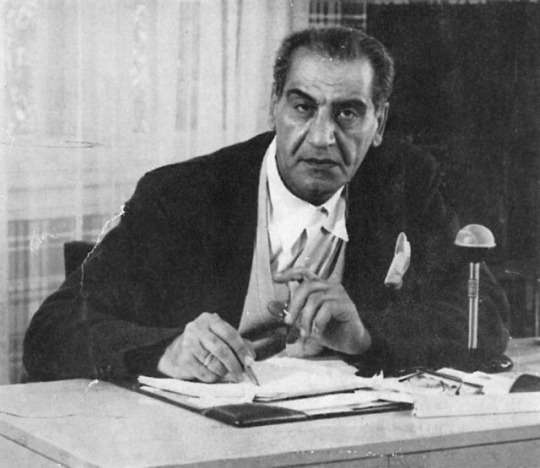
Silence—until it was shattered 58 years later, when, at the age of 78, having exhausted every peaceful avenue to draw the world’s attention to the Armenian Question and faced with nothing but ignorance, Gourgen Yanikyan fired 13 bullets at the Turkish consul and vice-consul. This singular act of defiance wiped 58 years of dust from the forgotten pages of Armenian history, forcing the world to confront the cause once again.By sacrificing his freedom, Yanikyan ignited a movement. His act became the catalyst for a wave of Armenian activism, inspiring the creation of ASALA, who would go on to fight for the recognition of the genocide.

In 1975, a group of Lebanese-Armenians led by Iraqi-Armenian Hakob Hakobyan, all of whose parents and/or grandparents were survivors of the genocide, inspired by Yanikyan’s self-sacrifice, decided to found an underground organization, which through armed actions will again bring the Armenian Question into the international political and legal dimension, present the recognition of the Armenian Genocide carried out by the turks in 1914-1923 by the international community, and create prerequisites for the liberation of Western Armenia. The organization was called ASALA - Armenian Secret Army for the Liberation of Armenia.
The military operations of the ASALA were mainly aimed at turkish embassies, consulates, diplomats, government officials, military and police institutions, the turkish business environment, especially the offices of "turkish airlines corporation", as well as the state and public structures of other countries, which showed financial or military support to the turkish state.
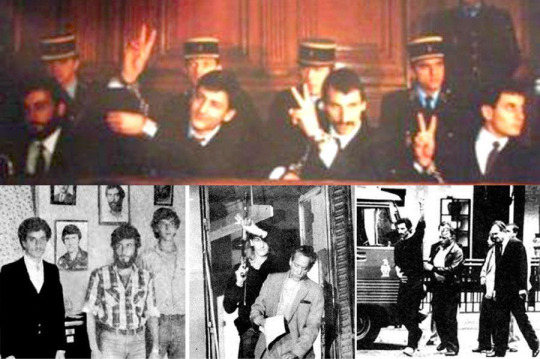
Now, why am I telling you about this today? Well, today - on September 24th marks the 43rd anniversary of the Van Operation (24/09/1981), carried out by 4 Armenian ASALA soldiers - Vazgen Sislyan, Hakob Julfayan, Gevorg Gyuzelyan and Aram Basmajyan. On this day in 1981, four Armenian youths, aged 20-24, armed with pistols, automatic rifles and explosives, seized the turkish consulate in Paris, holding it under their control for 15 hours.
youtube
4 Soldiers of The Van Operation taking off their masks
The trial of “VAN” turned into a trial of the turkish government. The “VAN” operation and the political trial that followed it played a major role in bringing the Armenian issue to the international political arena, globalizing the territorial claim and the violated rights of the Armenian people, creating a new wave of condemnation of the reality of the Armenian genocide, strengthening the pride and spirit of struggle among Armenians.
When all the hope has slipped away, It’s the mad who find a way.
Though violence is condemned, it is the cruel truth that it is the only language to which the world listens.
More about the Van Operation in the second part.
#break the chain of ignorance#armenian genocide#armenia#history#turkish crimes#azeri crimes#turkey#azerbaijan#asala#van operation#gurgen yanikyan#world politics#france#paris#september#baku gp 2024#cop 29#turkish tv series#translated literature#my translations#sorbonne
69 notes
·
View notes
Text
The String That Binds Us. (Chapter 1) | ln4, cl16
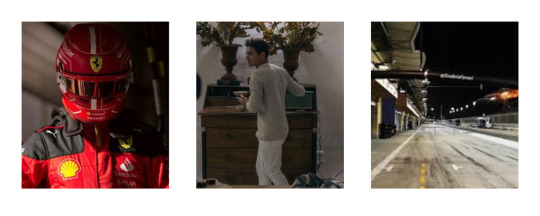
You fell in love with this sport all because of him. It would be selfish not to thank that boy for his help in getting you here today, even if you both ended on rocky terms. However, after finding yourself in the same paddock as your childhood bestfriend, your mentor, your first true love, and the boy who left you for the bigger picture, you realize that he wants nothing to do with you. So, as fate has it, perhaps you'll end up in the arms of someone else. Or maybe, just maybe, that string that has been tied to the two of you since birth will pull you back into eachothers lives.
Warnings : none
Pairings : Lando Norris x reader, Charles Leclerc x reader
Word Count : 1923
Poetry style | Story style
A/n: here, my lovelies, is chapter one. Not proofread srry lolsies.
Prologue | Chapter 1 | Chapter 2

one;
y/n.
There was something about it, something in the early morning rays reflecting off the cherry-red paint that just wiped away all exhaustion previously held in your bones. You were wide awake as you stared at the cars being rolled off the truck and into the garage. It was only five am but the sun had already crept over the horizon well enough to illuminate the sight in front of you. Golds and reds, blacks and yellows all mixed into a work of art nobody else could recreate. This is what you were here for. This is what you were living for.
“Gorgeous, innit’?”
You turned to your left, face to face with two others donning the same uniform as you. The woman who had spoken seemed a bit older than you, but now way had she yet reached her thirties. A man was accompanying her, although his eyes rested not on you, but on the tyres now being rolled out of the truck. He seemed close to her age, his deep-tanned skin a high contrast to hers.
You smiled at her before looking down at your lanyard. It was still so hard to process being here, on a Thursday morning in Bahrain, waiting for the weekend that was about to ensue. You were one of them now. You were an insider, a person that got to see everything on a deeper level. People dreamed of getting here, people worked their whole lives in hopes of getting here and yet here you were, 23 years old and face-to-face with Carlos Sainz’s car. It looked so much better in-person.
“It really is.” You sighed, looking back up. The truck was empty now, they were beginning to close the back door. “I still can't believe I’m here.”
The blonde lady leaned forward, trying to catch a glimpse of your badge. “Y/n y/ln? You're new, huh?”
You turned to meet her eyes, a large smile on your face. “Yes, I just graduated University.”
“What an amazing first job to have then.” She smiled back. The man beside her now looked at you as he adjusted the ballcap on his head. “I'm Bridgette, but everyone in the garage just calls me Bridge.”
“It’s a pleasure to meet you,” You extended out a hand which she gratefully accepted.
“This is Lorenzo.” Bridgette nodded to the man who offered a toothless smile and his hand. “Enough standing around, we’ve got work to do. Walk with us.”
So you did. The garage wasn’t too far away, just around the corner, but Bridgette loved to talk; that you quickly found out. “Where are you from?” Was her first question.
“Bristol.”
“I hear it’s nice. They’ve got that beautiful river running through it, no?” She asked, looking straight ahead. You just nodded, unsure if she saw your response, but when she kept going you assumed she had. “I’m from Perth. Nothin’ quite like Australia, I must say.”
“Isn’t Lando from Bristol?” Lorenzo added. His accent was thick as he spoke.
You nodded again, this time opting to expand on the question. “He is, yeah. We actually grew up together.”
Bridgette turned her head to look at you. “No way! Why didn’t your mate get you a job over at Mclaren?”
A blush coated your cheeks. You didn’t know where it came from, maybe embarrassment, maybe fear, hell, maybe even sadness. Lando wouldn’t have put in a good word for you, not today. Perhaps seven years ago when the two of you were teenagers and on a completely different page, but not now.
“We don't talk like we used to. He was gone a lot but he moved away for good when he was seventeen. He never really looked back, either.” You sighed. An odd sense of pity hung over the three of you. In an attempt to lighten the mood you clapped your hands together and smiled at the two engineers next to you. “But he got me into cars and engineering! So, I owe him a thanks for that.”
Bridgette nodded and pressed her lips into a thin line. “There ya’ go.”
The next few moments were rushed. The three of you entered the garage where people worked on putting everything into place. You were introduced to management and owners, mechanics and bosses. Tyres were being placed on racks, tarps were being placed over backup cars, tool boxes were being passed around. It was thrilling, even if you were just standing on the sidelines watching as it all happened. Soon, however, someone called your name. You were sure it was Bridgette or Lorenzo, but it was someone else. Alessandro, Charles' chief mechanic, was heading straight for you, clipboard in hand.
“Have you been assigned a team yet?”
“No, sir.”
He smiled. “Call me Alessandro. No need for formalities. But anyways,” He looked down at the clipboard then back up at you. “Our front jack guy broke his wrist and I need someone to replace him. Care to run some drills?”
You couldn’t stop the smile that spread across your lips. “I would be honored.”
“Awesome.” He nodded over his shoulder. “Let's go get you a suit and helmet, then.”
x
“I’d be surprised if you didn’t get the spot.” Bridgette sipped her coffee. “You absolutely crushed it.”
You blushed, rolling your finger around the rim of your cup. The Ferrari motorhome was gorgeous with its meeting rooms and rooftop balcony, with its relaxation spots and cafe. It really put into perspective where you were and who you were working for.
“Thank you,” You said quietly.
The day had gone by rather quickly. The sun was already setting over the desert and exhaustion clung to your body just as tightly as the uniform you wore. You’d spent hours running drills, practicing the most simple yet vital job-jacking the car up. You did it over and over again, improving with every run. After that you were tasked with doing inventory. Sure, it was a small task, one that didn’t require you to get hands on with the car, but it was still important. You wandered the garage counting tyres, drills, wrenches, going through tool bags and drawers. It helped you get situated in the space, to learn the layout and whereabouts of everything. Once you had finished that, you were offered to help wash Charles’ back up car. You gladly obliged, happy to be finally touching the car at least. You washed the tyres, the halo, the rear wing and a bit of the body before standing back to revel in the beauty of the car. It seemed to shine, even in the dim garage lighting. You felt so fulfilled, so privileged, so at home.
“Alessandro likes to give everyone a shot, he doesn’t discriminate.” Bridgette continued. “Today might have been your lucky break.”
“I’d be happy even being a back-up jack, honestly. Just wearing the fire suit and helmet makes me feel all,” you paused looking for the right word to describe it. “Giddy.”
“Well,” Lorenzo began, setting his phone face down on the table. “He needs to pick tonight so we can have that person participate in tomorrow's practice. You should know if you got it first thing tomorrow morning.”
“Guess I’ll be tossing and turning all night, then.” You joked.
A small laugh cluttered the table. It was getting late, the track becoming more and more empty with each passing moment. The motorhome was silent, save for the three of you lingering around. “We should go grab the last shuttle to the hotel,” Bridgette stood, taking one last swig from her cup before tossing it into a bin. “Are the two of you coming?”
Lorenzo stood up, as did you. “I left my bag in the lockers. I can wait for the next one if you both would like to go.”
“It’s ok,” he said. “We can wait for you at the front gate.”
“Alright, then. I’ll be quick.”
You jogged through the paddock, grateful that the heat had subsided. Lights poured out of each garage, illuminating pit lane in a way the sun hadn't. The sun, harsh and bright, brought a form of intimidation onto the pavement. The lights however, soft and orange, seemed to bring peace. It was a gentle reminder that at the end of the day, everything would be alright.
You dodged into the Ferrari garage, running to the back lockers to retrieve your backpack. Although your head was almost completely submerged in the metal box, you could hear faint-chatter? You leaned back, wondering if Bridgette and Lorenzo had come to find you. No, it didn’t sound like them. The voice sounded much more familiar. It was like listening to one of your favorite songs after a long while.
Lando paused at the entrance of the garage. His phone was pressed into his ear. He stared at you, eyes squinted and eyebrows furrowed. Did he know it was you? Could he see you? Did he even remember what you looked like?
You swung your bag over your shoulders and closed the locker. As you approached, Lando lifted his brows, erasing the confused look on his face. He surely could see you now.
“Hey, I gotta call you back.” He sighed. “Yeah, everything is good. See you tomorrow.”
A few feet separated you and him. You debated on starting conversation, on asking how he’s been. But you decide just to nod and walk past him. That is your plan until he stops you.
“Y/n?”
You pressed your lips together in a flat smile. “Hey, Lando.”
He looked you up and down. You were uncertain if he found your Ferrari uniform insulting or fitting. What if you were wearing papaya? What if you were sporting orange instead of red? Would he be looking at you in the same way?
“So you really did make it, huh?” Lando crossed his arms over his chest, smirking as you avoided eye contact.
“I suppose so.”
“Have they assigned you a driver?”
You looked up for the first time since your conversation began. A bit of pride swelled in your chest as you said, matter-of-factly, “Yeah, Charles Leclerc.”
He blinked hard, shocked that you landed not only a job with the most infamous F1 team, but on their star drivers car. Maybe you were better than you let on. Maybe it was more luck. But deep down Lando knew how good you were. He was able to experience it first hand as a kid.
“Wow. Most people remain without a designated driver for their first year. They kinda’ just float around doing all the dirty work. At least, that's how it is at Mclaren.”
“Right.” You gripped your backpack straps like a kid. “Good thing I'm not over there, then.”
“Yeah.”
The two of you fell quiet, only the sound of nearby passing cars and people walking by filled the air. To any bypasser this surely looked sketchy. Lando Norris, Mclarens golden boy, and a new engineer for an opposing team, just staring at one another. How odd.
You broke the silence first saying, “Well I’ve gotta’ go. I have some friends waiting for me to catch the shuttle.”
Lando just nodded, staring at the ground as you walked by. As you passed Carlos’ garage, he called out, “I’ll see you tomorrow, y/n.”
You could barely hear it with the way he spoke so quietly. But you stopped, turning your head and offering a real, genuine smile. “Yeah,” You breathed out.
He smiled back. “Good luck.”
#f1#formula 1#f1 fanfic#f1 requests#f1 imagine#f1 x reader#f1 series#charles leclerc fanfic#charles leclerc x you#charles leclerc x reader#charles leclerc imagine#charles leclerc angst#charles leclerc#cl16#cl16 x reader#cl16 imagine#cl16 x you#ln4 imagine#ln4 x reader#ln4#ln4 fic#lando norris x reader#lando fanfic#lando imagine#lando x reader#lando norris#lando norris ff
105 notes
·
View notes
Text
In the 1920s, a series of greed-based, racially charged murders of members of the oil-wealthy Osage Nation occurred in Oklahoma. (The linked article is a gift 🎁 link, so anyone can read the entire article, even if they do not subscribe to The New York Times.)
The article's authors, Jim Gray and David Grann, also point out how legislatures in red states like Oklahoma have created laws that are being used to prevent the teaching of significant racist incidents in American history for fear that it could be implied that students are being taught that they "'should feel discomfort, guilt, anguish or any other form of psychological distress' on account of their race or sex." Consequently, teaching about the Reign of Terror against the Osage Nation is being stifled in some Oklahoma schools.
Here is a video about the murders.
youtube
.Below are some excerpts from the article:
During the early 20th century, members of the Osage Nation in Oklahoma were systematically murdered by white settlers. Yet outside the Osage Nation, the history of this racial injustice — one of the worst in American history — was distorted and then largely erased from memory.
“Killers of the Flower Moon,” a film directed by Martin Scorsese, shines an extraordinary light on these events and provides a long overdue opportunity to restore them in our consciousness. But ironically, at the same time that the film is being released, there is a new attempt to suppress the teaching of this very history in the state where it took place.
In 2021 the Oklahoma Legislature passed a bill prohibiting teachers in public school from instructing several concepts, including that “any individual should feel discomfort, guilt, anguish or any other form of psychological distress” on account of their race or sex. The vagueness of the law has caused teachers to censor themselves, for fear of losing their licenses or their school’s accreditation. In a high school classroom in Dewey, Okla., copies of “Killers of the Flower Moon,” the nonfiction book behind the film, were left unread because the teacher worried about running afoul of the law. Another teacher confessed that she was uncertain if she could refer to the settlers who murdered the Osage as white.
At stake in these fights is not only factual accuracy. It is also how new generations will be taught to record and remember the past — both the good and the bad — so that they can learn to make their own history.
The story of what’s now called the Osage Reign of Terror is essential to understanding America’s past. After vast oil deposits were discovered under their lands, the Osage were suddenly, by the 1920s, among the wealthiest people per capita in the world. In the year 1923 alone, the roughly 2,000 Osage on the tribal roll received a total of more than $30 million, the equivalent today of more than $400 million.
As their wealth increased, though, it unleashed an insidious backlash across the country. The U.S. government passed legislation requiring many Osage to have white guardians to manage their fortunes — a system that was both abhorrently racist and widely corrupt. Then the Osage began to die under mysterious circumstances: There were shootings, poisonings and even a bombing.
[color emphasis added]
I encourage you to read the entire article. It is tragic that red states are so afraid of their racist past that they are making it extremely difficult for children in those states to learn about the racist underbelly of American history, and how that history continues to reverberate in our society.

_______________
Video source for gif (before edits/caption)
Originally posted 10.21.23; last edited 01.20.24
#osage murders#oklahoma#american history#killers of the flower moon#censorship#anti-crt legislation#david grann#jim gray#Youtube#the1920s channel#the new york times#my gifs#gift link
309 notes
·
View notes
Note
hii hellooo, may i request brothers with a clown core mc? their outfits most often being very colorful but their personality being the opposite? like somewhat cold and very blunt, not talking much and if talking then it’s about something mildly disturbing like murder investigations or an odd fascination with deadly diseases stuff like that
sorry that it’s extremely specific and thank you regardless _(┐「ε:)_
Clown Anon MCs - [ Clowncore MC | Death-Fixated Science Geek MC | LeVeyan Satanist MC ]
When you first arrived, no one was sure what to think. They looked you over. Your pink hair, your cyan shorts. A yellow T-shirt and rainbow suspenders. Gaudy makeup and adorable pink tennis shoes. Beaded bracelets and necklaces and colorful tights.
And a box of smokes in your back pocket.
"Welcome to the House of Lamentation," Lucifer says, gesturing grandly at the stately mansion ahead of you.
You say nothing. Instead, you pull out a cigarette and a lighter. Taking a drag, you lazily gaze at the house, then back at your host, who looks disgusted.
"Make sure you only do that outside," he says, nodding to the box of cigarettes in your hand.
You blow a puff of smoke in his face and start walking to the door, completely ignoring the sounds of Lucifer struggling to contain his rage.
"Why's it called that?" you finally ask as you stop at the front doors. "'House of Lamentation'?"
Lucifer, having composed himself by now, steps up beside you. "This is a replica of a house from the human world," he explains. "In it, an entire family was murdered; the parents, the servant, and six of their seven sons. The seventh--"
"Ohhh. This is the Sutton house," you say, nodding.
"Excuse me?"
"The Sutton house. Massachusetts, 1923. Elijah Sutton, oldest of seven sons, runs into the local tavern screaming that his servant killed the whole family and himself. Most folks today think it was Elijah who really did it. I know I do."
You take one more drag from your cigarette, then drop it on the ground and put it out with the heel of your shoe.
"So this is their house, huh? Sick."
---
It's breakfast on your second day in the Devildom. You took extra time to apply your godawful makeup this morning, and you're sure it shows, because the brothers keep glancing at you as if they're not quite sure what they should say.
"You talk to them, Mammon," mumbles Satan. "You're their babysitter."
"Ah... ahem." Mammon casts a glare at his brother, then looks at you. "So, uh... Human." You stare at him with a dead-eyed expression that seems to unnerve him even more. "...We're goin' to RAD today, and there's a couple a things you should know." You continue staring.
Mammon looks to his brothers for help, but they all avoid eye contact. "Uhhh... Just... try not to get eaten, 'kay? Lucifer'll be pissed if you die on my watch."
"Do demons eat people?" you ask. "Like, raw?"
"Sometimes! So don't mess around with 'em, got it?"
"That's gotta be messy as fuck."
"It is!"
"You got any photos?"
"....Eh?"
---
"So I get that you're the seven deadly sins," you say to Satan, sprawled out in an armchair in the library, "but like... is that all you guys got here?"
Satan, who had been minding his own business and innocently reading a book of curses, looks irritated. "Is that all of what?"
"I dunno. Bad shit shaped like people." You shrug. "Like, you got the Four Horsemen or somethin'?"
"Of course not," Satan snaps. "That would be ridiculous."
You shrug. "Embodiment of plague? Too ridiculous to believe. Embodiment of wrath? Well, obviously that's a thing."
---
"You have to make pacts with Lucifer and his brothers," Belphie urges you through the door. You stare at him, then take a drag from your cigarette. As long as Lucifer is occupied in the music room with that weird record, you're going to break every rule in this damn house.
"How am I supposed to do that? Am I gonna split up my soul Horcrux style? Give everybody a slice?"
Belphie stares at you for a few seconds. You don't realize how badly he wishes he could kill you in this moment. "Are you going to help me or not?"
You shrug. "What do I get out of it?"
He blinks at you in utter bewilderment. "You... make me happy?"
You stare at him. He stares at you. You stare at him. He continues to stare at you.
You head back down the stairs.
#clowncore#clowncore mc#obey me#obey me shall we date#obey me swd#obey me mammon#obey me satan#obey me lucifer#obey me belphie#lucifer#satan#mammon#belphie#daytaker fanfic#obey me headcanons#dthc#hcs#ask response#anon#obey me mc#obey me writing#i hope this is what you were asking for anon#i think it's appropriately silly
157 notes
·
View notes
Note
Do you know how our understanding and treatment of diabetes has changed through history?
Oooh good question, anon!
As you may guess, diabetes mellitus is not new.

We've known about it since at least the Ebers Papyrus (1550 BCE) when the disease and a treatment was first described. This treatment was: "a liquid extract of bones, grain, grit, wheat, green lead and earth." I did not look these up, but I would guess they did not do a whole lot for the treatment of diabetes.
Later during the 6th century BCE it was first given a name when it was described by Hindu physician Sushruta as madhumeh or "honey urine."
Honey urine is a very apt descriptor for diabetes. In any type, one of the most measurable symptoms is that the person urinates a lot, and the urine tastes sweet (or, if one didn't feel like tasting, that it ferments, or that it attracts ants). This was also the first test for diabetes.
The reason for the sweetness of the urine (as well as a lot of other general info about diabetes) is spelled out more clearly in my "Don't Be That Guy Who Wrote Hansel and Gretel: Witch Hunters" post.
A Greek physician Apolonius of Memphis named it Diabetes, meaning "to siphon" (referring to the large amount of urine lost).
Roman physician Aretaeus later made the first precise description of diabetes. This included the classic symptoms of incessant thirst, copious urination, and constant hunger leading to emaciation and death. He also notes that if deprived of water, the patient will continue to urinate until they become so dehydrated that they die.
The term "Mellitus" was not added until the 1600s by an English physician Thomas Willis. This was again due to the sweetness of the expressed urine. Willis prescribed a diet of "slimy vegetables, rice, and white starch. He also suggested a milk drink which was distilled with cypress tops and egg whites, two powders (a mixture of gum arabic and gum dragant), rhubarb and cinnamon". Supposedly his patients improved if they kept to this diet, though few managed it long term. I honestly don't know how it would have worked, even temporarily.
A major breakthrough came in 1889 when it was discovered that if you removed the pancreas from a dog, the dog would become diabetic (particularly, that it would urinate large quantities of sweet urine). Up until this point it was thought that diabetes stemmed from the kidneys and bladder, or perhaps the lungs. This was the first time it had been shown experimentally that the pancreas was the problem.
Speaking of this, this was also part of a series of experiments where an English physician named Merkowski implanted a small amount of pancreas in the pancreas-less dog's fat, which reversed the diabetes temporarily. This proved that the pancreas was making something that helped regulate blood (and thus urine) sugar.
What this was wasn't figured out until 1921, when Canadian scientists Banting and Best (with help from McLeod and Collip) isolated something they called insletin (after the islets of langerhans, where the substance was being produced). It's important to note that all of these scientists hated each other so much they almost refused a Nobel Prize over it. Later, Collip would refine the substance and McLeod would rename it insulin.
Prior to insulin existing there was basically 1 vaguely useful treatment for diabetes. Unfortunately, that was starvation. So you could either die a slow and painful death by diabetes or you could die a slightly less slow but still painful death due to eating about 500 calories per day. Either way, diabetes was fatal, usually within a couple of years of diagnosis.
By 1923, the first commercial insulin product, Iletin, had been developed. Iletin was a U10 insulin (10 units per 1 milliliter- less potent than today's U100 and U500 insulins) and was made from pork pancreases. It took nearly a ton of pork pancreas to make 1oz of insulin. Fortunately, as a byproduct of the meat industry, pancreases were readily available.
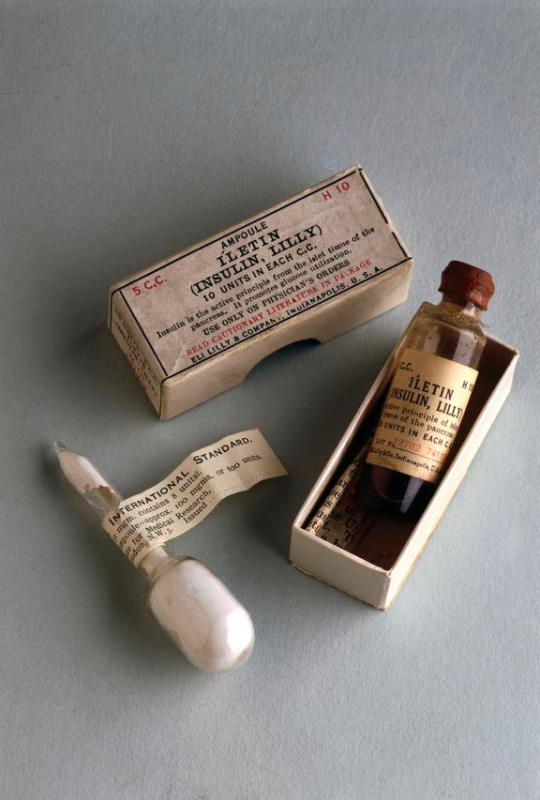
Now, you might be thinking- no one has mentioned type 1 or type 2 yet in this entire post!
Well, you would be right, because diabetes wouldn't be split into 2 forms (insulin-dependent and non-insulin dependent) until 1979, and wouldn't be classified as types 1 and 2 until 1995. That's right- some of you were alive when there was only one kind of diabetes out there.
Now, there's more about the types in the Hansel and Gretel post, but essentially type 1 diabetes occurs when the pancreas itself stops producing insulin, usually in childhood. When this happens, the body stops being able to use sugar (insulin, a hormone, acts as a "key" to let sugar into cells for use). Without replacing that insulin, the person dies because their cells starve.
Type 2 diabetes occurs when the pancreas still produces insulin, but the cells stop responding to it correctly. This causes high sugar levels in the blood, which causes longer-term complications (infections, ulcers, blindness, neuropathy, heart and kidney disease, hyperosmolar syndrome, etc..) which eventually lead to death.
We started discovering oral drugs that worked on what would later become type 2 in the 1950s. Particularly those that worked by increasing the insulin output of the pancreas, but only when the pancreas was still producing some insulin.
Predicting which diabetics would benefit from oral therapies was challenging, but it was recognized that when the onset of diabetes was slow and came on in adulthood, the oral agents would work, while if it came on suddenly in childhood, the oral agents wouldn't. Terms like "adult onset" and "maturity onset" were common:

(Side note: if you have ever read Alas, Babylon (1955) there is a diabetic character who by today's standards clearly has type 1 diabetes, but wants to switch to the "new oral pill" (called "orinase" in the book, though they are likely referring to diabinese pictured above).)
From 1923 into the 1980s, insulin was given once or twice per day, and not particularly titrated to blood sugar. This was probably just because we didn't have a great way to measure blood sugar in real time. Pre-1970s, there was no way to test blood sugar outside of a lab setting.

Urine testing was common starting in the 1940s, but was cumbersome as it required a flame for heating the urine. By the 1950s, a test had been developed that didn't require a flame, but was still not practical for home use. In the 1960s, paper strips were developed that changed color for different amounts of sugar in the urine. The problem with this was that the strips couldn't change color until there was sugar in the urine- a blood sugar level of over 200 by today's measurements. Low blood sugar readings were impossible at this time, and had to be treated based on symptoms.
In the 1970s, blood sugar could finally be measured by putting a drop of blood on a test strip, wiping it off, and matching the color of the test strip to a chart. While less cumbersome than urine tests, this was still something that would generally only be done at a doctor's office.

In 1983, the first home blood glucometer is developed. Finally, it was practical to take one's sugar multiple times per day, and it becomes possible to experiment with "sliding scale" insulin injections that keep tighter control of blood sugar. By the late 90s, continuous glucose monitors became available- though unlike today's CGMs that allow readings in real time on a smartphone or monitor, these had to be downloaded to a computer at regular intervals.
The 1980s were the first decade where insulin pumps become widely available. The very first pump was large and had to be carried in a backpack, but it represented a huge step forward in glucose control, as it more closely mimicked the function of a working pancreas than once-daily injections.
For the next 30 or so years you really had to work to qualify for an insulin pump, but recently it's been found that pumps greatly improve compliance with blood glucose control whether or not the person had good compliance before getting the pumps, and insurance has gotten better about covering them (though CGMs are still a pain to get insurance to cover).
The 1980s was also the decade that recombinant human insulin (insulin made by genetically modified bacteria) was first used. Up until that point the only insulins were pork and beef insulins, which some people had allergic reactions to. Recombinant insulin was closer to regular human insulin than beef or pork, and represented a big change in how insulin was made.
Today for people who take insulin to manage their diabetes, insulin is usually given as a single injection of a long-acting basal insulin, coupled with smaller doses of ultra-short-acting insulins with meals or snacks. This is the closest we've gotten to mimicking the way a pancreas would work in the wild, and keeps very tight control of blood sugar. This can be done by fingerstick blood sugar tests and individual injections of insulin, or it can be done with a CGM and pump- it just depends on the resources available to the person and their personal preference.
112 notes
·
View notes
Text



Yes, I was away again for an unplanned amount of time, but here I am again, but I hope I won't be as absent as before.
YES I'M BACK WITH MY NEWER SURPRISES! And it won't be the same as before. And soon you will see.
For now, Happy 100th Anniversary Disney! Although I have all kinds of objections to the current policy of this company, I still thank them for the excellent animated films and classic shorts that they have made from 1923 until today. Especially the most important characters like Donald, Oswald, Mickey, Goofy, Pete, Horace, Clarabelle, Minnie, Ortensia, Daisy, Pluto, Huey, Dewey and Louie, Jose and Panchito, Chip and Dale, Scrooge, Ludwig and others. As well as great movies like Snowhite, Pinocchio, Dumbo, Bambi, Cinderella, Alice in Wonderland, Peter Pan, 101 Dalmatians, The Jungle Book, Winnie the Pooh, Robin Hood, Black Cauldron, Oliver and Company, Rescuers, The Little Mermaid, Beauty and The Beast, Aladdin, The Lion King, Pocahontas, The Hunchback of Notre Dame, Hercules, Mulan, Tarzan, The Lost City of Atlantis, The Emperor's New Suit, Treasure Planet, Lilo and Stitch and many more. And almost everyone together on the occasion of the 100th anniversary celebration. Thanks to Eric Goldberg for this, as well as the other animators. Unfortunately, certain characters are not shown here.
What is your favorite movie and who are your favorite characters from here? Once again, happy 100th anniversary!
If you like this, feel free to like and reblog this with your favorite characters and movies.
#happy 100th anniversary#disney#once upon a studio#group photo#disney movies#disney cartoons#cartoons#mickey mouse#donald duck#goofy#huey dewey and louie#scrooge mcduck#the three caballeros#dumbo#pinocchio#snowhite#aladdin#lion king#tarzan#hercules#alice in wonderland#the little mermaid#mulan#treasure planet#101 dalmatians#robin hood#the lost city of atlantis#lilo and stitch#beauty and the beast#cinderella
282 notes
·
View notes
Text
"Trans people can be heterosexual, but they can't be straight" is a stupid fucking take because not only does it misgender transhets, it's also just not the way language works.
The argument tends to be that "straight" refers to having a "normative" or "socially acceptable" sexuality, which heterosexuality tends to be seen as, but isn't in the case of transhet people.
It's true that "straight" has historically been used that way. For example, Transgender Warriors (1996) includes the line "The trans population is a reminder that not everyone who is heterosexual is straight!" (page 92). At this point, straight had a meaning that was distinct from heterosexual, with straight meaning "not queer" and heterosexual meaning "attracted to the opposite gender."
However, straight (in reference to sexuality) and heterosexual have both had a lot of different meanings over time, and it's pretty stupid to pick one at random and go yes, this is the true correct meaning.
The terms "heterosexual" and "homosexual" appear in a letter by Karl Maria Kertbeny in 1869. Homosexual refers to erotic acts between two men or two women, and heterosexual refers to erotic acts between women and men. But Kertbeny still considered heterosexuals to be degenerates, as they engaged in nonprocreative sexual acts. (The Invention of Heterosexuality, pg. 33)
In 1892, Dr. James G. Kiernan used the word "heterosexual" in a Chicago medical journal. In this case, heterosexual referred to people who felt "inclination to both sexes." The hetero- prefix didn't refer to being attracted to a different gender than one's own, but to being attracted to two different genders. (The Invention of Heterosexuality, pg. 21)
Then, in 1893, Richard von Krafft-Ebing published Psychopathia Sexualis, where he used the term "hetero-sexual" to refer to sexual desire or "sexual love" between men and women, and is used to mean a "normal" sexuality. (The Invention of Heterosexuality, pg. 22)
In 1901, a medical dictionary defined "heterosexuality" as "Abnormal or perverted appetite toward the opposite sex." (The American illustrated medical dictionary, pg. 300)
In 1923, Merriam Webster defined "heterosexuality" as "morbid sexual passion for one of the opposite sex." Then, in 1934, the definition was changed to "manifestation of sexual passion for one of the opposite sex." (Merriam Webster's New International Dictionary, pg. xcii; Webster's New International Dictionary Second Edition, pg. xcvi
For much of the early history of the term "heterosexual," it was used interchangeably with the term "normal-sexual." (Straight: The Surprisingly Short History of Heterosexuality, pg. 14)
The use of "straight" in reference to sexual orientation was defined in the 1941 book Sex Variants "To go ‘straight’ is to cease homosexual practices and to indulge--usually to re-indulge--in heterosexuality." It didn't refer to people whose innate sexual orientation was to be attracted to a different gender than their own, it referred to "ex-gays," or gay people who had recloseted themselves. (Origin of Everything, around 2:56)
From there, "straight" evolved to mean non-queer (as we saw in the Transgender Warriors quote), and now it's pretty much synonymous with heterosexual, being attracted to a different gender/the other binary gender from your own.*
*this isn't a perfect definition ofc because no sexuality can be defined perfectly, but it's better than "opposite gender"
So, over time, straight has meant "ex-gay," recloseted gay, non-queer, and heterosexual (as we know it today), and heterosexual has meant degenerate attraction between women and men, bisexuality as we know it today, abnormal/perverted attraction to the opposite sex, normal sexuality, and finally, attraction to a different gender/other binary gender.
And with all those meanings, it's kind of ridiculous to insist transhets are heterosexual but not straight based on just one of the many ways each word has been used. I could just as easily say that transhets who identified as gay before transitioning are straight because straight has been used to mean "ex-gay," and cishets who have never identified as gay aren't straight. Or that cis people attracted exclusively to the opposite binary gender aren't heterosexual, because heterosexual has been used to mean attraction to two different genders.
All that aside, both "heterosexual" and "straight" came into use with cis as the assumed default, without making the distinction between gender identity and sexual orientation that we have today. Transhets have no obligation to adhere to the definitions of either of those terms that operate under the assumption that everyone is cis.
And again- saying that transhets aren't straight is misgendering us. That should be the only thing that matters, but since clearly it doesn't, maybe it'll matter that enforcing "normative (cis) sexuality" as a universal definition for straight is bullshit.
#i actually did have a lot of fun with this research#except for the part where i couldn't find an available copy of sex deviants so i had to just use the video as a source. that was annoying#but all of this stuff was really interesting and i learned a lot yippee#i think 'abnormal or perverted appetite towards the opposite gender' is how i'm gonna define my heterosexuality from now on#transhet#'straight: the surprisingly short history of heterosexuality' is actually really interesting btw#didn't read all of it but. i liked it and will probably try to read the rest at some point
65 notes
·
View notes
Text
okay okay lemme just explain this real quick because oh my dark gaia i have so much to say about the aerated bread company
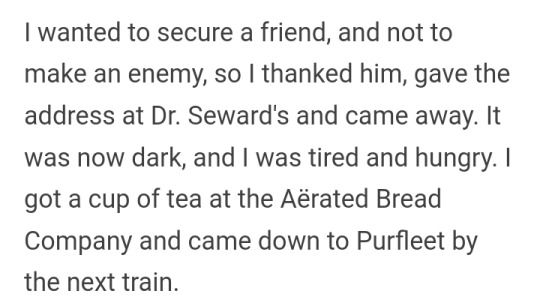
okay to start it off, the aerated bread company was originally a bakery chain in london known for a special method of making bread with machines that skipped the fermentation process used by most bread makers at the time by putting carbon dioxide into the process and producing carbonic acid gas.
this very element of the aerated bread company was widely debated as some people saw the way the bread was now kneaded by machinery and made quickly with carbon dioxide as a step into the future and some saw it as an abandoning of the traditional ways of bread making.
john dauglish, the inventor of the method and founder of the company, received an patent for the method in 1856, received a silver medal from the royal society of the arts, and had his methods highly recommended by many physicians and sanitarians at the time, even using the method in hospitals due to the cleanliness of the machine bread. the process was also cheaper and made it so the company could sell it at lower prices than other london bakeries. it was so well received that even americans were fascinated by the dauglish bread making process. while it is no longer used today, the process lasted for a century or so before being replaced by the chorleywood bread process which is now still in use today.
not everyone was a fan however. many classic bakers saw the innovation as a blasphemy to the way bread was supposed to be done. they believed that fermentation was the only way to make bread and that by taking that and hand kneading out of the process, the aerated bread company was doing a disservice to the art as a whole. traditional bread makers, in order to combat the cheapness of the aerated bread company's bread, marketed their usage of gin in their traditional bread as it was thought to have medical benefits at the time due to the juniper berries fermented to make it. despite this however, the aerated bread company continued to be popular with rapidly rising stocks and continued demand with bakery after bakery opening in the area
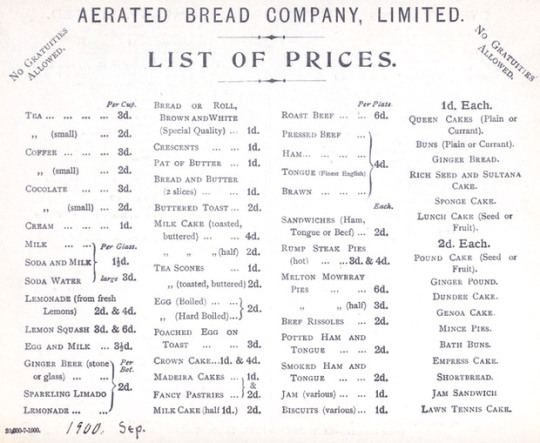
however, bread wasn't the only thing made by the aerated bread company as you may have figured out from this short mention. in 1864 they opened their tearoom in fenchurch street railroad station and the chain only grew from there. many things were offered in addition to tea as you can see from the menu above. at the aerated bread company's peak in 1923 they had 250 tea shops in london, other towns in england, and even sydney, australia!
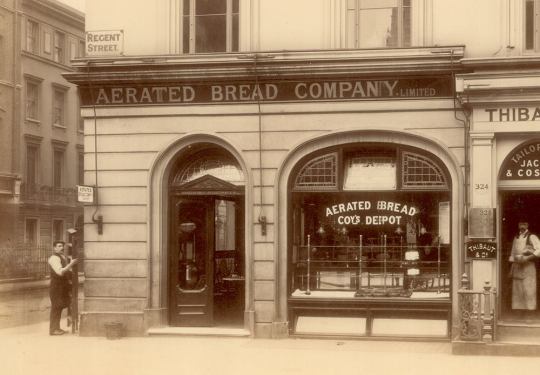
just like the bread-making process that gave the aerated bread company it's name however, the tea shops had quite a bit of controversy. one of the biggest things going for them was the stores involvement in the women's right movement (making this particular choice of tearoom interesting at a time when mina is currently being disregarded by the men in her life) the tearooms were one of the first public places in victorian england where women could eat alone or with women friends, without a male escort. women's social clubs would even be set up above the shops in a few rare instances. this was complicated slightly by the poor payment of women workers by the company, they did not even originally pay women workers which eventually changed when protest was raised by women who frequented the tearooms. despite this, it was recommended by women's rights activists as a good place to organize and socialize without male escorts.
not everyone liked the tearooms though. one particularly bitter opponent to the tearooms was george orwell, author of books such as animal farm and nineteen eighty four. he stated on the shops that they were a "sinister strand in English catering, the relentless industrialisation that was overtaking it...everything comes out of a carton or a tin, or is hauled out of a refrigerator or squirted out of a tap or squeezed out of a tube" also one customer in a sydney tearoom claimed to have found a mouse baked into her pie, sueing for a thousand euros. the claim was found to be faked and the judge did not rule in her favor but it was still interesting
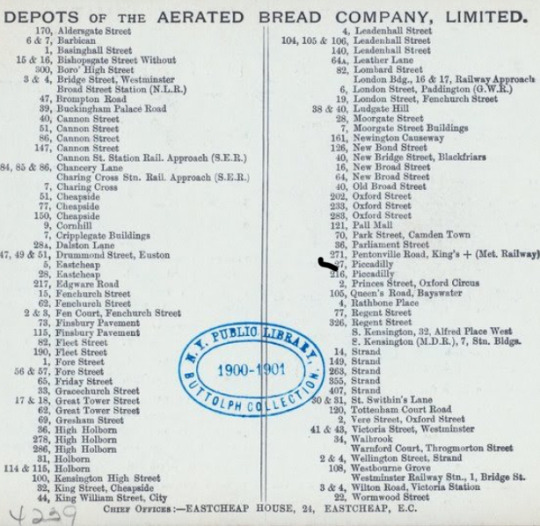
what happened to the aerated bread company? well, it did very good for a long period of time but like all good things (or at least somewhat good things) it came to an end. nothing really interesting happened in its closing, parts of it were liquidated in other countries and it was bought by the allied bakeries in 1955. the company ceased operations fully in 1982 and now all that is left of the aerated bread company are the ghosts of signs left over the doors to other shops.
and that's the aerated bread company for the interested!
#dracula#dracula daily#mina harker#jonathan harker#i really care about this subject for no reason so here you go
1K notes
·
View notes
Text
honesty
On ao3 here.
CW: Brief reference to domestic abuse.
1923
Esme flopped onto the freshly made bed with a sigh, arms outstretched.
Her husband watched the scene for a moment. Then delicately picked up one arm, lying down beside her, and letting her arm fall over his body. His shoes were kicked off with his toe — falling unceremoniously on the floor with a thwack — before pulling his legs onto the mattress.
When she had insisted the first piece of furniture they built in their new-to-them home was their entirely unnecessary bed he thought she was endearingly silly. Yet, there was something to be said about the familiar comfort after a week of traveling across the continent.
His eyes slipped closed, listening to her unnecessary breathing, calm, slow, and steady. She was hoping to finally be reintroduced to human society and was doing everything possible to make it a successful transition. He felt the mattress shift as she moved closer, her shoulder bumping into his as she threaded her fingers through his.
He presumed he was as close to the sleep as he ever would be. Comfortable and somnolent. Warm from the sun shining through windows that did not yet have coverings. Birds chirping in the backyard. His wife by his side, the honeysuckle of her shampoo mixing with the fresh scent of the soap she used to wash their linens.
“May I be honest with you?” She asked quietly.
“I hope you are always honest with me, Esme,” he muttered.
He heard her blow air out of her nose, and knew, even without peeling his eyes open, she was smiling fondly.
“I feel safer now.” He felt her lift their joined hands off the bed, holding them upright, tilting them slowly. No doubt watching the thousands of beams reflecting off their unnatural skin.
“In this house?”
The house was located further from civilization than the former hunting lodge, minutes away from a small logging town, they had occupied in Wisconsin. The structure itself was larger, the newlyweds and the perpetual teenager finding they needed far more space than the previous two bedrooms. Structurally he questioned its soundness, it needed quite a few renovations. But Esme’s smile when she caught a glimpse of the slightly dilapidated project in his countless brochures ensured he was purchasing the property.
“In this country,” she said, letting their hands fall to the mattress with a quiet thunk.
“Oh?” He opened his eyes, blinking slowly, lazily turning his head to look at her. Her eyes were fixed on the ceiling.
She did not continue, although he knew she could. Vulnerability no longer came naturally to Esme. She had reached a point in life where almost every word she spoke was mulled over laboriously before it met the air. The only person who ever got a look at her bare thoughts was a telepath Carlisle pitied and envied.
“Penny for your thought?”
“I believe… I have known in the logical portion of my mind Char- he no longer posed a threat to my well-being. I know that. Yet, when I saw the map today, and realized how far from home I was, it felt as if I could finally breathe.”
“Are you sure that’s not the mountain air?” He smiled.
“It might be,” she laughed lightly, rolling her head to look at him.
“I wish I had known you felt unsafe. We could have moved sooner. I presumed you might find it difficult to leave any earlier.”
Indeed she had found it difficult to leave the place where her son was buried. “Worthless mother,” and “abandoning him” were the only words he could discern as she tearlessly sobbed into his shoulder two weeks earlier.
“But that is precisely my point. I never felt unsafe, at least in the moment. Only in hindsight.”
“Small mercies?”
“Indeed,” she smiled. She let go of his hand, reaching up to brush a stubborn lock of hair off his forehead.
They fell into what he had nicknamed ‘comfortable silence.’ There was little pressure to fill the void, the silence could sit, be peaceful even. It was one of the elements of marriage he found most surprising and gratifying.
He watched as she closed her eyes and scooted closer, resting her head on his chest. His arm wrapped around her back.
“You used the word home,” he said after fifteen minutes or so.
“I misspoke, my home is here, with you,” she said quickly, correcting what she assumed was a transgression.
“Es, I only wished to know where you were referring.”
“I suppose Ohio,” she sighed. “It is humorous because it did not when I was there.”
“Oh, I understand that sentiment entirely.”
“You do?”
“Yes, I would never step foot in London again, and yet if someone asks me where I am from my mind immediately goes to that grey dreary awful city.”
“You would never go back?” She asked, looking up at him. He nodded causing a wrinkle between her brows. “That’s a pity. I have always dreamed of going one day, in the far, far future.”
“Perhaps I could be convinced by an enchanting woman,” he conceded.
“If only I knew where to find one,” she laughed, triggering his laughter. He caught her lips in a quick, familiar kiss.
She broke the embrace with a contented sigh, lying her head back on his chest.
“Did Ohio ever feel like your home?” He asked, threading his fingers through her hair.
“You can not let a dead dog lie,” she sighed into his chest.
“I’m curious about my wife. Is that a crime?”
“You are too curious for your own good, Carlisle Cullen.”
“A trait we share.”
She took a deep breath, he could feel her body rise and fall against his. “I think it must have been the day I told my parents what he had done. I remember feeling entirely alone, clutching a cold rag to my eye to stop the swelling, while my mother went on a tirade about how difficult marriage was. I distinctly remember thinking there was very little left for me in life.”
“You have never told me about that day.”
“I told you they turned me away,” she refuted.
“Yes, but never anything further.”
“What would you like to know?”
“Only what you care to share,” he said. Her breathing halted, her body tightening under his hands. He continued speaking, “You do not have to tell me a thing, Esme. But I know when you broach a subject first you have been thinking of the manner for quite some time.”
She huffed, but he could feel her cheek move as she smiled.
“Recently,” she said, shifting off his chest, moving to tuck into his side to look at him comfortably, “I have begun to doubt my father ever knew what Char-he ever did.” He knew she corrected herself on his account, and as her husband, he should feel guilty about this fact, but when it came to Charles Evenson his rage often trumped his desire to be a supportive husband.
“I thought you said you told him.”
“When I got home he was in the fields,” she sighed as if lifting a heavy object.
For the first year after her transition, Esme had refused to discuss her past, unless entirely necessary. Only after much hurt and passive disagreements did she reveal this was due to the grief, and not lack of trust in her new companions. With clearer eyes the sorrow was evident, the slump of her shoulders, the spaces she left between words, the tone that made it feel as if every word was an exertion of energy.
“I told my mother, everything. She had not said a word in response, besides offering me a rag. He came in for a glass of water. My back was to him. I can no longer remember his face the last time I saw him but I remember the joy in his voice. He kissed the top of my head and asked the reason for the visit. Before I could answer my mother told me to go wash up. When I came back she told me he was going to drive me home in the buggy. I would still have time to make dinner.”
“And you suppose she did not tell him?”
“I presumed she had for the longest time.”
“What has caused you to doubt now?”
“Edward.”
“Edward?”
“Knowing Edward. Make no mistake I would have done anything for my son, but he was a babe. There was a part of me that assumed I could not understand my father’s indifference because I did not know the struggles of raising an impertinent child. But becoming well acquainted with Edward and all his flaws. I know I know I am not his mother, and I do not wish to be, but I care for him. If he confessed a fraction of what I had that day, I believe I would be compelled to commit a massacre. I can no longer conceive how my father would have driven me home, would have held polite conversation with my husband, if he had any idea.”
“Your mother knew, yet she arranged for him to take you back.”
“My mother never cared for me,” she said plainly.
“I am sure, she lov-”
“No, she did not. She told me as much, countless times. She never wished for children. I have accepted this long ago. But my father adored me. He would take me everywhere with him, he would just beam as he introduced me. ‘This is my little girl, Esme Anne.’ That first year of marriage he came by our house. I was in no shape to receive company and Charles asked him to leave. A few months after Charles enlisted he left a meal on our doorstep. He did not knock or leave a note — he could not write. But I know the taste of Platt beef. I am convinced he must not have known.”
“Perhaps he did not.”
“I was cruel to him.”
“Esme, I am sure he understood why you did not contact him. Even if he did not know precisely what you were experiencing.”
“At my brother’s funeral, he approached me, and I made some wicked comment about both his children being dead and how happy he must be,” she laughed humorlessly, a sound that bordered a sob. “Knowing now the pain he was facing, I can never forgive myself. Even if he knew.”
“You were hurt, you believed the one who was supposed to love you had thrown you into cruelty-”
“Carlisle, I do not need justifications,” she said softly, yet firmly, palm pressing to his chest.
“I understand,” he muttered, pressing a kiss to her forehead. “I love you.”
A true sentiment, one not meant to comfort or justify. I love you and the cruelty you see when you face a mirror. I love you and the fishing weights tied to your ankles in the form of memories I will never fully understand. I love you.
She pulled herself away from their embrace, forcing herself to sit up with a quiet groan. Her knees went to her chest, her arms wrapping around her shins, her chin resting atop her knees. He followed suit, tucking one leg under himself and letting one fall to hang off the bed.
“I apologize for being so morose,” she said quietly, her hair moving ever so slightly in the Summer breeze.
“I would rather know your true heart than be told empty pleasantries.”
She shook her head. “It is not your responsibility to carry my burdens.”
He laughed, “I believe that is the definition of marriage, my love. You have certainly carried your share of mine.”
She shrugged, tilting her head on her knees to see him better.
“Is the move the only element that has brought up all of this?” He asked delicately.
She nodded. “It feels as if Esme Platt, Evenson, Bauer is gone, finally. I knew she was before, of course. I knew I could never go back but being here, in an entirely new place feels as if Esme Platt is finally dead.” No sooner had she finished speaking was she laughing. “How dramatic.”
“I for one, hope you are wrong.”
“Hm?”
“I’m quite charmed by Esme Platt… and her impertinence,” he smiled, bumping her shoulder with his. It earned him a small smile. “Can I tell you something?” She nodded. “I loathe moving.”
“You do?”
“Oh yes. It feels as if the second I am content, I must pack up an entire life and move somewhere else unfamiliar and drab. Another town with another set of people I have to reinvent myself for.”
“So hundreds of ends?”
“I suppose. But I don’t know if it ends, in a sense I could be hundreds of Carlisles, and Williams, and one John.”
“You went by John?”
“Once, for two weeks. I moved because I could not force myself to respond to the name,” he smiled. “But they’re all me.”
“So this is a death and a birth? I like the sound of that.”
“You are an artist, aren’t you?” He laughed. She ducked her head. The fight over her clearly God-given talent was a battle for a different time, they had uncorked enough for one day. “Thank you for being honest with me,” he said earnestly. In one move, she pressed a kiss to his cheek and was on the other side of the room beginning to unpack one of their trunks. It was a start. A birth of newfound trust, one would say. Now he sounded like the artist, but not a very good one.
54 notes
·
View notes
Text


In 1047 BCE, a confederation of Hebrew tribes came together to found the Kingdom of Israel, the first ever unified, sovereign nation state in the history of the land. Though some historians have cast doubt on the existence of a unified Israelite state, in recent years, more and more archeological evidence has suggested that some form of unified state existed, though its grandiosity as depicted in the Torah is contested.
In 930 BCE, the Kingdom of Israel split into two: the Kingdom of Israel to the north, also known as Samaria (after its capital “Shomron,” or Samaria in English), and the Kingdom of Judah to the south. The term “Jew” comes from “Judahite,” as in, “someone from the Kingdom of Judah.” In Hebrew, the words for “Judahite” and “Jew” are the same word: Yehudi.
Our closest ethnoreligious brothers, Samaritans (or Shomronim in Hebrew), are the descendants of the citizens of the northern Israelite kingdom.

When the Babylonian Empire conquered Judah in 587 BCE, the territory of the Kingdom of Judah went on to become a province of the Babylonian Empire (587-539 BCE), the Persian Empire (539-332 BCE), the Seleucid Empire (332-37 BCE), and finally, the Roman Empire, which is depicted in green in the map to the left. “Judea” is merely a Romanized version of “Judah.”
After the Romans crushed the Bar Kokhba Revolt in the year 135, Emperor Hadrian carried out a retaliatory genocide against the Jewish people that took some 600,000 lives. Part of his genocidal agenda was to erase any trace of Jewish presence and autonomy in the land. To do so, he dissolved the Roman province of Judea and united it with Syria, creating Syria-Palestina. Syria-Palestina was then divided into Palestina Prima, Palestina Secunda, and Palestina Tertia. “Palestine” derives from “Philistines,” the ancient enemies of the Israelites in the Hebrew Bible. They were of Greek origin, unrelated to today’s Palestinians.
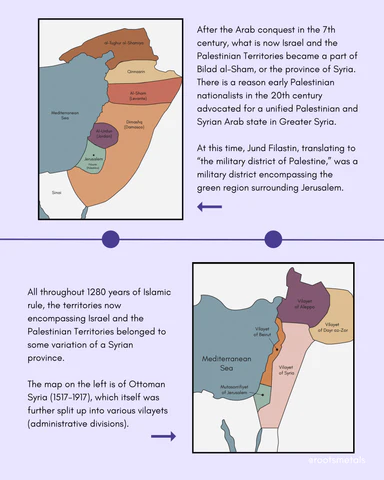
After the Arab conquest in the 7th century, what is now Israel and the Palestinian Territories became a part of Bilad al-Sham, or the province of Syria. There is a reason early Palestinian nationalists in the 20th century advocated for a unified Palestinian and Syrian Arab state in Greater Syria.
At this time, Jund Filastin, translating to “the military district of Palestine,” was a military district encompassing the green region surrounding Jerusalem.
All throughout 1280 years of Islamic rule, the territories now encompassing Israel and the Palestinian Territories belonged to some variation of a Syrian province.
The map on the left is of Ottoman Syria (1517-1917), which itself was further split up into various vilayets (administrative divisions).
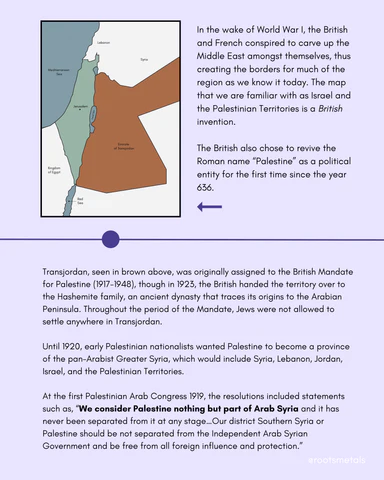
In the wake of World War I, the British and French conspired to carve up the Middle East amongst themselves, thus creating the borders for much of the region as we know it today. The map that we are familiar with as Israel and the Palestinian Territories is a British invention.
The British also chose to revive the Roman name “Palestine” as a political entity for the first time since the year 636.
Transjordan, seen in brown above, was originally assigned to the British Mandate for Palestine (1917-1948), though in 1923, the British handed the territory over to the Hashemite family, an ancient dynasty that traces its origins to the Arabian Peninsula. Throughout the period of the Mandate, Jews were not allowed to settle anywhere in Transjordan.
Until 1920, early Palestinian nationalists wanted Palestine to become a province of the pan-Arabist Greater Syria, which would include Syria, Lebanon, Jordan, Israel, and the Palestinian Territories.
At the first Palestinian Arab Congress 1919, the resolutions included statements such as, “We consider Palestine nothing but part of Arab Syria and it has never been separated from it at any stage…Our district Southern Syria or Palestine should be not separated from the Independent Arab Syrian Government and be free from all foreign influence and protection.”
ORIGINS OF ISRAEL
The earliest known mention of “Israel” in history — and the earliest mention of Israel outside of the Torah — is 3200 years old and was discovered in Thebes, Egypt, in 1896.
The mention is found in what is known as the Merneptah Stele, an inscription by the ancient Egyptian pharaoh Merneptah, who reigned between 1213 BCE to 1203 BCE. The Stele itself is dated to 1208 BCE. It’s written in ancient Egyptian hieroglyphs.
The Merneptah Stele mainly describes Merneptah’s victory over the ancient Libyans. However, three of the 28 lines talk about a separate Egyptian military campaign in Canaan. It reads:
“The Canaan has been plundered into every sort of woe:
Ashkelon has been overcome;
Gezer has been captured;
Yano’am is made non-existent.
Israel is laid waste and his seed is not;
Hurru is become a widow because of Egypt.”
The hieroglyphs used describe Ashkelon, Gezer, and Yano’am as city-states, whereas “Israel” is described as a foreign (to Egypt) people. This suggests that at this point in time, the Israelites did not rule over a unified state, but rather, were a nomadic or semi-nomadic tribe(s). This would corroborate the narrative of the Torah, as the Kingdom of Israel did not become a unified state until some 161 years later.
As a side note, it’s interesting that the first ever mention of Israel in history comes from a ruler bragging about our supposed destruction. Over three millennia later, here we are.
In 1040 BCE, a loose confederation of Hebrew tribes united to form the first centralized state in the Land of Israel, known as the Kingdom of Israel.
The Hebrew tribes originated -- and later split away -- from the Canaanites, a loose group of semi-nomadic tribes that lived during the second millenium BCE; they were the original inhabitants of the Land of Israel. Though depicted as the enemies of the Israelites in the Torah, archeologists, linguists, Biblical historians, and geneticists today widely agree that the ancient Hebrews were originally Canaanites themselves. The Tanakh itself even makes some vague references to the Hebrews’ Canaanite origins. Ezekiel 16:3 tells us, “Thus said the sovereign God to Jerusalem: by origin and birth you are from the land of the Canaanites — your father was an Amorite and your mother a Hittite.” The Amorites were a Canaanite people.
It was customary at the time and in the region for nations to name themselves after their most important deities. For example, Israel’s neighboring Assyria named itself after the Mesopotamian deity “Ashur.” “El” was the most important god in the Canaanite pantheon; over time, the cult of El and of the southern deity YHWH merged to form the Hebrew God as we know Him today. “Israel,” then, translates to “one who wrestles with El [that is, God].”
Until 1948, the United Kingdom of Israel (1047-930 BCE), the southern Kingdom of Israel (930-722 BCE), and the Kingdom of Judah (930-587 BCE) were the only ever sovereign nation states in the entirety of the land’s history. At all other times, the region was a colony, vassal state, or province of some foreign empire whose administrative center was elsewhere. The founding of the State of Israel in 1948 marked the first time that the land belonged to a fully sovereign, independent state in over 2500 years.
ORIGINS OF PALESTINE
Historians have long debated the origins of the name “Palestine.” Most believe that the word derives from the Hebrew and Ancient Egyptian word “peleshet,” translating to “invader” or “migratory.” “Peleshet” was used to describe the Philistines, who settled on the Mediterranean coastline above Egypt, in parts of what is now Israel and Gaza. The Philistines were a seafaring people of Greek origin, entirely unrelated to today’s Palestinians, who are an Arab ethnonational group. Some Palestinians, particularly Christian Palestinians and Palestinians from the city of Nablus, have Jewish and Samaritan ancestry, respectively.
The first use of the word “Palestine” to describe a geographic region was in the 5th century BCE, at least 700 years after the first use of the word “Israel.” Like the Land of Israel, “Palestine” was a loose region, describing the coastal strip that runs from Egypt to Lebanon. However, unlike “Israel,” Palestine was not a political entity until the Romans renamed Judea “Syria-Palestina” in the second century CE.
Another, newer, more controversial theory asserts that “Palestine” derives from the Greek word “Palaistes,” meaning “wrestler.” If you recall, the term “Israel” means “one who wrestles with God.” According to this theory, “Palestine” is a direct Greek translation of “Israel.”
For hundreds of years, the term “Palestinian” was virtually synonymous with “Jew.” In the 18th century, for example, Immanuel Kant described the Jews in Europe as “the Palestinians among us.” In the early 20th century, Jews used “free Palestine” as a rallying call to establish a Jewish state.
The first Arab Palestinian to identify as Palestinian was Khalil Beidas in 1898, though the term was not universally used until the 1960s. During the 1937 Peel Commission, Palestinian Arab nationalist Anwi Abd al-Hadi told the British, “Palestine is a term the Zionists invented!”
WHY IS THE STATE OF ISRAEL "ISRAEL"?
Though the second Kingdom of Israel was conquered by the Assyrians in 722 BCE, both Jews and Samaritans continued referencing to the land as “Eretz Israel,” or the Land of Israel, for three millennia. When the Maccabees briefly gained a semblance of independence after the Maccabean Revolt (167-141 BCE), they referred to their new semi-autonomous kingdom as “Judea” and “Israel” interchangeably. During the Bar Kokhba Revolt against the Roman Empire (132-135 CE), the revolt leader, Simon Bar Kokhba, was known as the “prince of Israel.”
Even during the British Mandate (1917-1948), the official name of Palestine was the “British Mandate of Palestine (Aleph Yud).” Aleph Yud are the letters corresponding to the abbreviation for “Eretz Israel,” the Land of Israel.
Even so, most assumed that the new Jewish state would be called “Judea,” or “Yehuda” in Hebrew. In 1949, on the first anniversary of the State of Israel, Zeev Sharef, who had been present during the deliberations, explained why the name “Judea” was quickly discarded: “Most people had thought that the state would be called Judea. But Judea is the historical name of the area around Jerusalem, which at that time seemed the area least likely to become part of the state...So Judea was ruled out.”
The Provisional Government of the State of Israel also spent some time deliberating on what the name for the country would be in Arabic. Initially they considered Palestine, or "Filastin" in Arabic, to "take the feelings of the Arab minority into account." But the idea seemed too confusing, because they assumed an Arab state would be established alongside the Jewish state, and that Arab state would likely be called Palestine. As such, the idea was discarded. Instead, Israel is called "Isra'il" in Arabic.
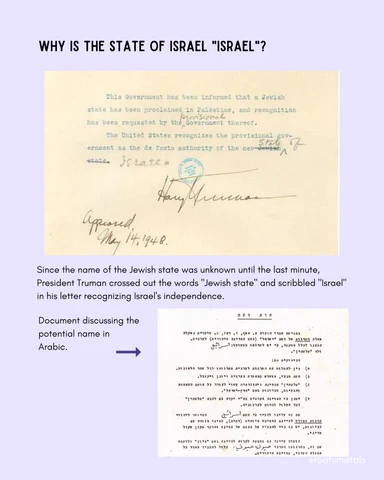
Since a lot of you guys seem to have a problem with reading comprehension, let me comprehend this for you: the point of this post is *not* to say only Jews have a right to live in the land, or to say that I unequivocally support everything the Israeli government has done, is doing, & will continue to do forever into eternity.
the point is: (1) the idea that Israel is “colonial” is ahistorical & antisemitic because it is a blatant erasure of Jewish history & identity, (2) the idea that Palestine is “anti-colonial” is also ahistorical and also an erasure of Jewish history, & (3) the “river and the sea” that you’re so damn attached to in the name of “anti-imperialism”?Yeahhhh those borders were a British invention.
For a full bibliography of my sources, please head over to my Instagram and Patreon.
26 notes
·
View notes
Text
Whitewash is extremely moral. Suppose there were a decree requiring all rooms in Paris to be given a coat of whitewash. I maintain that that would be a police task of real stature and a manifestation of high morality, the sign of a great people. -- Le Corbusier
A shocking call for compulsory whitening is made at the end of a key modernist manifesto. The pronouncement is associated with the signature whiteness of modern architecture -- an aesthetic regime that was presented as a complete revolution of the built environment in the 1920s and became the unconscious default setting of everyday life. Just look at the predominantly white background of most of the kitchens, offices, living rooms, bedrooms and bathrooms around the world [...]. Le Corbusier didn’t simply call for whitewash to be imposed by the police in the name of health. It was meant to act as a form of policing in its own right, a technology of surveillance that would put in motion an ever-expanding culture of self-policing. Whitewash exposes every dimension of life in front of it to judgement. It acts like “a court of assize in permanent session” that will “give a power of judgement to the individual,” and thereby “make each one of us a prudent judge.” [...] A “Law of Ripolin” -- the brand name of the hard impermeable and washable enamel “sanitary paint” invented at the end of the nineteenth century [...] is needed to ensure that all interiors are painted white to target any form of dirt or darkness:
Imagine the results of the Law of Ripolin. Every citizen is required to replace his hangings, his damasks, his wall-papers, his stencils, with a plain coat of white ripolin. His home is made clean. There are no more dirty, dark corners. Everything is shown as it is. Then comes inner cleanness [...]. When you are surrounded with shadows and dark corners you are at home only as far as the hazy edges of the darkness your eyes cannot penetrate. You are not master in your own house. Once you have put ripolin on your walls you will be master of yourself. [...]
---
Whiteness manufactures health, morality, and intelligence. [...] The office of a modern factory that is “clear and rectilinear and painted with white ripolin” is a place of “healthy activity” and “industrious optimism.” [...] Le Corbusier’s routinely authoritarian and often explicitly eugenic and fascist impulses, associations, and actions make him an easy target. But there are endless, quieter, ultimately more controlling and insidious celebrations of whiteness in other hands. Le Corbusier is but a tip of the vast iceberg of whiteness. [...]
The very idea of an interior is the effect of this everyday violence. Architecture is never simply complicit with authority. Authority without architecture might not even be thinkable. [...]
There is no apolitical concept of health; no natural body or brain waiting to be cared for or abandoned by medicine and architecture that is not already an effect of those biopolitical regimes.
It is through the question of sickness that architecture reshapes the human. The idea of a healthy architecture is always about the health of a small group relative to multiple others [...]. Whiteness is coded as a fragility requiring protection through continual acts of preemptive violence. Whiteness is not a thing but a defense and deployment of power over others. [...]
---
Whiteness in Le Corbusier’s The Decorative Art of Today, for example, is simultaneously the most modern thing to do, the very symptom of modernity, and the most ancient of gestures. [...] Le Corbusier’s argument was first published in a late 1923 issue of L’Esprit Nouveau [...]. It was, after all, the extended “Voyage d’Orient” of 1911 (including the Balkans and Greece, but especially Turkey) where Charles-Édouard Jeanneret, the young architect from a small mountain town in Switzerland who would a decade later rename himself “Le Corbusier,” became “besotted with white” and convinced that the future of architecture was white. Whiteness is discovered in the lands of the non-white; of those seen to be closer to deeper human history and therefore to be admired and learned from. In fact, the very point of going to the East was to encounter its “great white walls” as an antidote to the self-absorbed decadence of architecture in the North, as Jeanneret explained [...]. Jeanneret expresses nostalgia for the more intact and mesmerizing whiteness of the great mosques and vernacular houses of Constantinople (Istanbul) [...] [and] “Algiers-the-white.” [...] This pervasive sense of contamination provoked the call for a second, more explicit law to impose whiteness not only onto industrial culture, but also onto its victims: the people of color and places seen as newly “unhealthy” -- requiring, as it were, a dose of “their” own medicine. [...]
---
The “white” architecture of the 1920s drew on countless experiments in whitening buildings in the name of health. This included, precisely, the use of Ripolin that had already become standard in clinics, hospital wards, and sanatoria rooms at the turn of the century.
In 1899, for example, the Touring-Club de France, inspired by one of its [...] cyclist members who was a doctor, started a campaign for an easily disinfected “hygienic room” in hotels that would be Ripolin-lined [...]. Hotel rooms were treated as hotspots for contagion [...]. Given the largely upper-middle-class membership of the club, this anxiety about disease was also class anxiety, fear of the unclean other. The tourist was to be mobile yet isolated by a prophylactic whiteness that would itself travel in advance.
The Touring-Club exhibited such a prototype “white room” with toilette and toilet spaces designed by Gustave Rives at the 1900 Exposition Universelle in Paris -- strategically placed just inside the entrance of the Palais de l’hygiène [...]. The Touring-Club installed a series of such model chambres hygiéniques in automobile shows, congresses on tuberculosis, and international fairs. It was successful in persuading thousands of hotels to install such spaces [...].
Ripolin was used “everywhere,” for example, on the walls of the “hygienic housing” project for workers in Paris by Henri Sauvage and Charles Sarazin in 1903–1904. [...] The project was originally intended to feature a radical all-glass street façade with every window surrounded by webs of floor-to-ceiling hexagonal glass blocks [...] which would have been the most polemical housing structure possible, the most therapeutic role of glass, more extreme even than any sanatorium. The design was produced in immediate response to the new public health law of 1902 and the associated new building regulations. [...]
---
It is always about control of the threatening other of epidemic disease and control of the laboring poor, itself coded as dark, migrant, and contagious, a disease in its own right. And throughout this discourse of control, there is a seemingly “modern” disdain for disease-incubating ornament in favor of smooth white surfaces. [...] What is remarkable in the end is this trans-historical resilience of whiteness [...]. It orchestrates life and death.
---
All text above by: Mark Wigley. “Chronic Whiteness.” e-flux (Sick Architecture series). November 2020. [Bold emphasis and some paragraph breaks/contractions added by me.]
#ecology#abolition#health#imperial#colonial#landscape#modernity#temporal#indigenous#multispecies#tidalectics#archipelagic thinking#pathologization#haunted#halloween i guess idk#victorian and edwardian popular culture#racialized architecture#moral whitewash
236 notes
·
View notes
Text
IWTV S2 - ANOTHER commercial teaser!? Analysis & EP5 Theories
Lord, I have places to be in the morning, but AMC thinks it's cute to release multiple teasers in a day. 😭
tumblr

This is a SPICY one for Louis, too! 👀

We start with the familiar "Me n' you; you n' me" from Louis, but we see a teensy bit more of his fallout with Claudia:


Claudia's head is being pushed down into something as she screams.
And thanks to the teaser we got earlier today, we can assume Lou's in the burlap sack the (the night the Theatre jumps him, Claud & Madz).

They jump from Claudia yelling at Louis, to Louis yelling "YOU left ME!" I NEED to know who Louis is talking to--it's a hard cut from Claudia to Louis, but I bet he's talking to someone else.
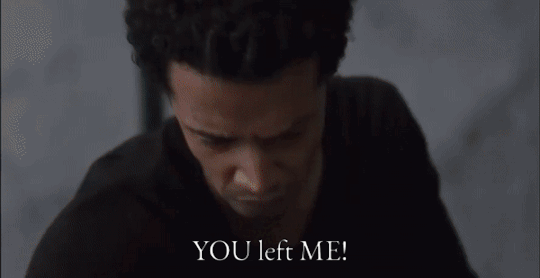
Cuz of the cut to Armand looking concerned as he calls Lou's name (Merrick?), now I'm thinking about the books, where we know Armand left Louis (in IWTV) for Daniel (in QotD). So is that a Loumand argument? 👀 Cuz I'm telling y'all, I don't trust them in Dubai, and the goat Carol Cutshall already threw shade their way, with the "so-called love of his life" line. I'm side-eying them HEAVY.
And good grief, poor Louis' going THROUGH IT in his dark room.

But the REAL reason I'm posting all this is cuz of this juicy morsel:

😳 LOUSTAT KISSING IN EPISODE 5 FOOTAGE. 😳
AMC, what in heaven's name is HAPPENING!?
Neither Louis nor Lestat are injured here, so does this clip happen:
1) In 1931, right before Claudia came home?
2) Or even earlier, back in 1923, when Loustat was arguing about Claudia's "hunger strike"? Cuz we know Louis wore the same blue sweater TWICE in Ep5.


3) OR, this is legit from the Ep5 fight, while they were upstairs, during the parts we didn't see while they were in the coffin/bedroom?

Was it "over" cuz Louis was desperately tryna kiss and make up? Did it not work, cuz Lestat knew/convinced himself that Lou was playing him--"maybe it's the gin, my love"? Cuz Les is the one to push Louis through the wall.
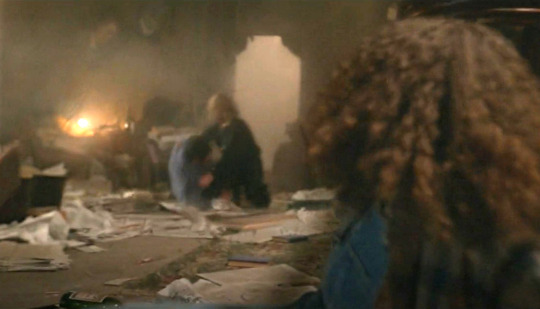
I dunno, I need sleep. 😫
[EDIT] I'm dead wrong (and blind).
Thank you so much @loustat-0 -- yup, I just saw @squirrellypoo's post explaining that you have to really crank up the lighting to be able to tell that this is Louis' jean jacket from Hallucination!Lestat we've seen in 1000 other trailers, NOT the blue sweater from EP5.
Thank GOD, cuz I went to bed just DREADING what people would start saying about Ep5. 🤦
#interview with the vampire#louis de pointe du lac#justice for claudia#loustat#loumand#iwtv tvc metas#the hype is real#videos
35 notes
·
View notes
Text

MWW Artwork of the Day (5/26/24)
Owe Zerge (Swedish, 1894-1983)
A Violinist Tuning his Instrument (1923)
Pencil on paper, 58.8 x 46.1 cm.
Private Collection
A painter of portraits, figure subjects, flower pieces, landscapes and nudes, Zerge received a large number of portrait commissions, through which he seems to have earned his livelihood, although his other paintings, particularly the flower pieces, also sold well. As he himself noted, in a 1976 interview, ‘I paint so incredibly old-fashioned. But I think you should see what is represented. I cannot with the best will in the world think that it makes a person better by putting an eye on the forehead and nose on the chest.’ Although Zerge’s works are today to be found in the museums of Gävle, Kristianstad and Tomelilla in Sweden, he remains largely forgotten in his native county.
42 notes
·
View notes
Text
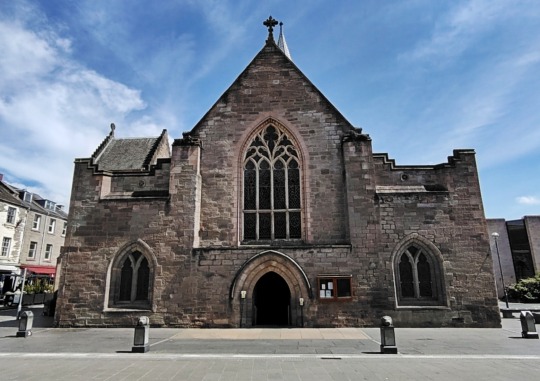
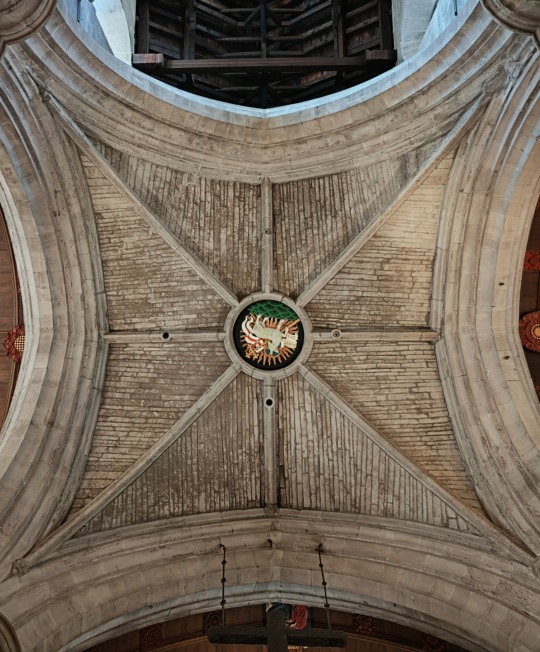
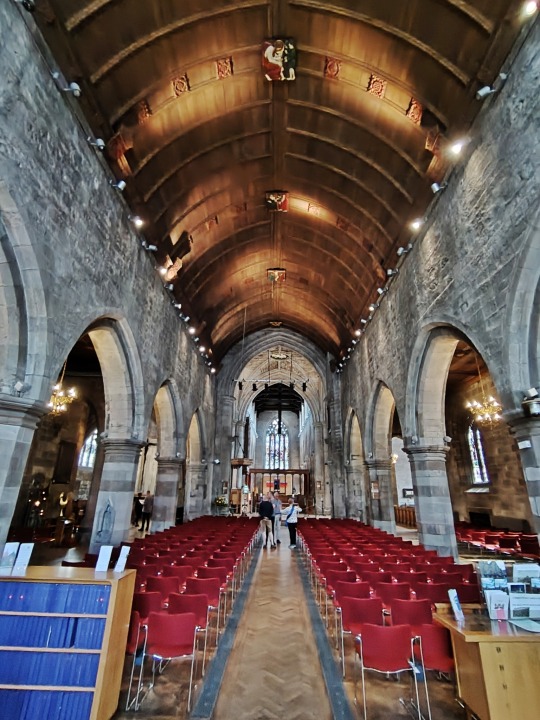
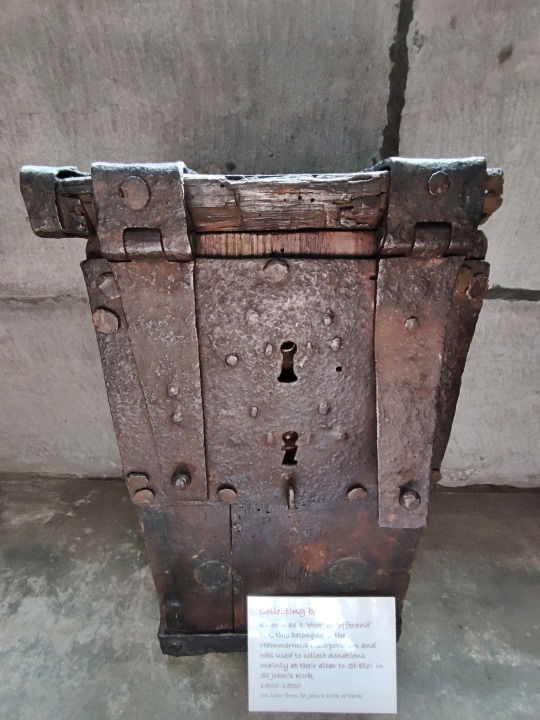
St John's Kirk Perth.
The oldest church in the Fair City started life back in the early I lth century. This was about 200 years before the town was granted the status of royal burgh in 1208. St John's Toun would go on to give it's name the their football team, St Johnstone.
The church was largely rebuilt in 1448 and just over a hundred years later John Knox preached here kindling the Protestant Reformation in Scotland.
The burgh's graveyard surrounded the kirk until it became completely full in 1580. Five hundred years of burials raised the ground, that's why you have to step down into the kirk, you wonder how many bodies lie beneath your feet as you walk around the perimeter.
St John's Kirk was first mentioned in 1126 and it's first incarnation completed in 1241.
A new choir was added to the building in 1440 and more improvements up to about 1448.
During the Reformation, the angry congregation destroyed all forty altars to saints in the kirk and the 4 monasteries around Perth, more on the Monasteries to come!
After the Reformation, St John's was partitioned when the parish was split into three congregations. The kirk was remodelled in 1923.
What you see today was reestored by Sir Robert Lorimer, who also designed the Thistle Chapel in St Giles on The Royal Mile, which I posted pics of a few days ago, and the Scottish National War Memorial, which I posted about yesterday in Scottish & Proud, as it was officially opened on July 14th 1927.
Part of the old church was torn down to improve traffic flow as the City flourished during the Georgian era.
It's a fine church, but my favourite item in the building is in the fourth pic, it's a collection box. Called a 'Sanct Eloys Offerand Stok" it would once have sat on the altar of The Hammer men Incorporation for donations to be received for the poor.
The "Stok" was mentioned in The Hammermen Incorporation minutes as early as the Year 1518, but is thought to be about a hundred years older, so this simple wee box survived the reformation and the centuries since.
Much more photies to come!
20 notes
·
View notes